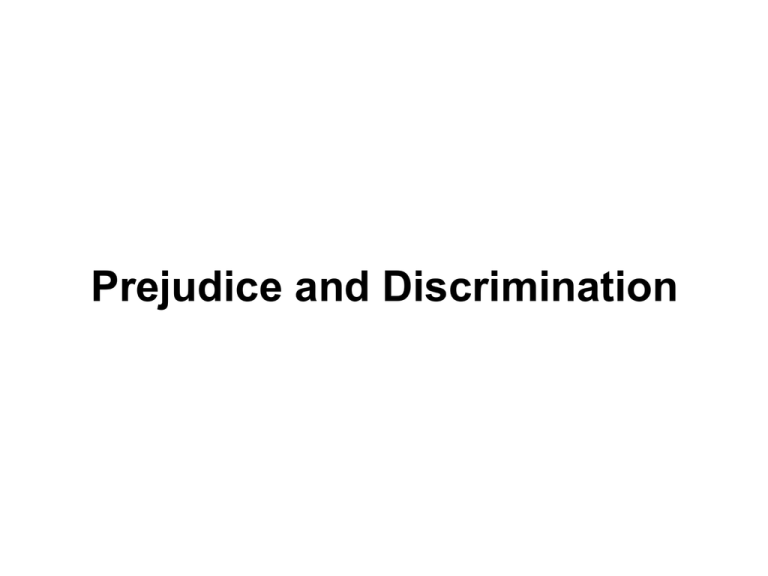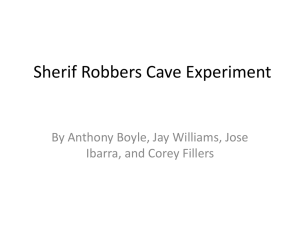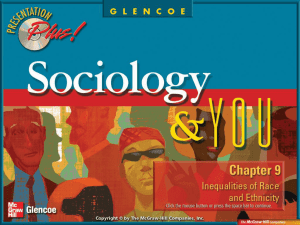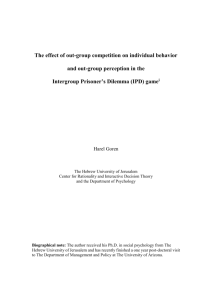out-groups - psychinfinity.com
advertisement

Prejudice and Discrimination I. Stereotypes, Prejudice, and Discrimination A. Stereotype: a generalized belief about a group of people in which identical characteristics are assigned to virtually all members of the group, regardless of actual variation among the members. B. Prejudice: an attitude or feeling, favorable or unfavorable, toward a person or group of people, prior to, or not based on, actual experience. C. Discrimination: an unjustified negative or harmful behavior toward a member or members of a group simply because of their membership in that group. D. Reverse Discrimination: when, in an effort to act on behalf of people who have been discriminated against in the past, people end up discriminating against another group. II. The Many “isms” of Prejudice and Discrimination I. Racism: an individual’s or group’s prejudicial attitudes and discriminatory behaviors toward people of a given race or ethnicity. A. Individual Racism: the racist acts of one person based on conscious or unconscious prejudice. B. Institutional Racism: when economic, educational, political, social, and corporate institutions favor one race or ethnicity over another. C. Cultural Racism: the discriminatory acts of one race or ethnic group against another race or ethnic group, at times attempting to change or eliminate the other group. D. Racial Discrimination… Does it still exist? E. Are most people individual racists? 1) Subtle Racism 2) Automatic Racism The Implicit Attitude Test II. Sexism: an individual’s or group’s prejudicial attitudes and discriminatory behaviors toward menor women. A. Gender Stereotypes: the perceived cognitive, affective, and behavioral traits possessed by females and males, and that distinguish the two sexes from each other. B. Women are seen as kind, nurturing, and considerate (positive) as well as dependent, weak, and overly emotional (negative). Thus, women are “warm” (nice) but they are not competent. C. Men are seen as decisive, assertive, and accomplished (positive) and aggressive, insensitive, and arrogant (negative). These traits are thought to show that men are a higher status group than women. D. The Women are Wonderful Effect! E. Benevolent Sexism… Women: Women have a superior moral sensibility. Men: Men are powerful. F. Hostile Sexism… Women: Once a man commits, she puts him on a tight leash. (He’s whipped!) Men: Men are immoral. G. Gender Role: a set of behavioral expectations (norms) for males and females. H. Gender Discrimination… Does it still exist? I. Glass Ceiling: a barrier based on attitudinal or organizational bias that prevents qualified females from advancing to top-level positions. J. Glass Elevator: when men enter predominantly female occupations, they may get an easy ride to top-level positions or at least get promoted much faster in these occupations. K. Tokenism I: hiring based on group membership. 1) Token hires are liked less by their coworkers and viewed as less competent. L. Tokenism II: when individuals perform trivial positive actions for members of out-groups that are later used as an excuse for refusing more meaningful beneficial actions for members of these groups. 1) For perpetrators of tokenism, prior positive actions serve as a credential that indicates their “non-prejudiced” identity, which in turn frees them to later discriminate. III. Ageism: discrimination against people of a certain age group, typically older people. IV. Classism: discrimination against people of a certain socioeconomic status. V. Other Common Categories of Prejudice and Discrimination A. Religion B. Culture C. Attractiveness D. Obesity E. Homophobia III. Prejudice and Discrimination: Different Groups… Different Feelings A. Some theorists have argued that prejudice is more than just generic negative feelings toward a group, but rather is comprised of distinct negative emotions. B. Depending on what emotion underlies prejudice toward a particular group, the discriminatory action that might be expected could be different. 1) When people’s prejudice primarily reflects anger, they may attempt to harm the out-group directly. 2) Prejudice based on pity or guilt might lead to avoidance of the out-group because of the distress their characteristic can evoke. IV. Social Influence in Prejudice and Discrimination A. Social Learning and Conformity… 1) We form ideas and feelings about other people which lead to behaviors directed towards other people from observing and conforming to the attitudes and behaviors of others we like or believe (family, friends, the media, etc.). B. Authoritarian Personality: a personality that is disposed to favor obedience to authority and intolerant of out-groups and those lower in status. C. Ethnocentric: believing in the superiority of one’s own ethnic and cultural group, and having a corresponding disdain for all other groups. D. Social Dominance Orientation: motivation to have one’s group dominate other social groups. Being in a dominant high-status position tends to promote this orientation and justification. V. Motivational Influence in Prejudice and Discrimination A. Scapegoating: the idea that you use a particular person or group of people (usually people not in a position to effectively retaliate) to act out aggression upon in order to vent frustration. B. Realistic Group Conflict Theory: prejudice and discrimination arise from competition between groups for scarce resources. C. Social Identity Theory: the “we” aspect of our self-concept; the part of our answer to “Who am I?” that comes from our group memberships. This involves three steps… 1) We categorize: “I’m an Italian, a Democrat, a Biologist” 2) We identify: We associate ourselves with certain groups (in-groups: “Us” – groups of people who share a sense of belonging, a feeling of common identity) and gain self-esteem by doing so. 3) We compare: We contrast our groups with other groups (out-groups: “Them” – groups that people perceive as distinctly different from or apart from their in-group) with a favorable bias toward our group. D. In-Group Bias: the tendency to favor one’s own group over another group. E. Out-Group Rejection: the tendency to demonstrate dislike for an out-group. 1) As in-group size decreases, in-group bias and outgroup rejection increases. F. Terror Management Theory: when people are primed to think about their mortality, they become observably hostile to people with different beliefs (out-groups) and observably more fond of people with similar beliefs (in-group). This serves to reduce the activated anxiety associated with thinking about dying. G. Group-Serving Bias: making internal attributions for positive in-group and negative out-group behaviors, while making external attributions for negative in-group and positive out-group behaviors. H. Evolutionary Survival Instinct: difference is a sign of danger. VI. Cognitive Influence in Prejudice and Discrimination A. Social identity theory implies that those who feel their social identity strongly will concern themselves with correctly categorizing people as us or them. B. Out-Group Homogeneity Effect: the perception of out-group members as more similar to one another than are in-group members. C. Own-Race (and Own-Age) Bias: the tendency for people to more accurately recognize faces of their own race and own age. D. The Ultimate Attribution Error: the tendency to make dispositional attributions from one individual’s characteristics or behavior to an entire group of people. E. Subtype: a subset of a group that is not consistent with the stereotype of the group as a whole due to multiple distinctive features. F. Stigma Consciousness: a person’s expectation of being victimized by prejudice or discrimination. G. Just-World Phenomenon: the tendency for people to believe that the world is just and that people therefore get what they deserve and deserve what they get. VII. Prejudice and Discrimination: Consequences and Remedies A. Stereotype Threat: people’s perceived risk that they might do something that supports an unfavorable stereotype about their group. B. Do Stereotypes Bias Interpretations of Interactions? C. Do Stereotypes Bias Judgments of Individuals? D. Contact Hypothesis: the idea that prejudice and discrimination will decline as we have more contact with people who we would have discriminated against. E. Mutual Interdependence: the need to depend on each other to accomplish a goal that is important to each group. Robbers Cave Experiment







